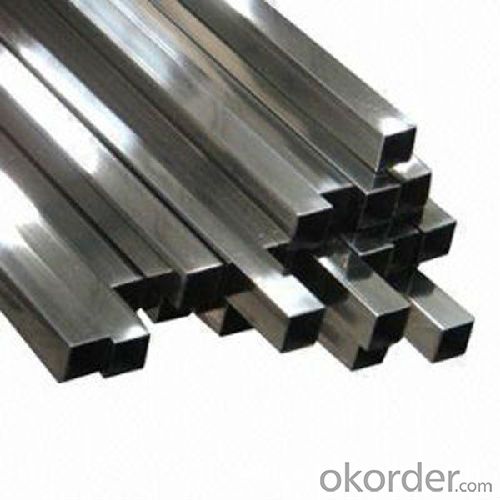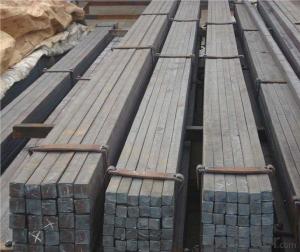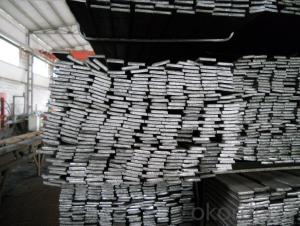Steel Square Bar High Quality 5mm-100mm Q195 or Q235
- Loading Port:
- Shanghai
- Payment Terms:
- TT or LC
- Min Order Qty:
- 50 m.t.
- Supply Capability:
- 20000 m.t./month
OKorder Service Pledge
OKorder Financial Service
You Might Also Like
Product Description:
OKorder is offering High Quality Square Bar 5mm-100mm Q195 or Q235 at great prices with worldwide shipping. Our supplier is a world-class manufacturer of steel, with our products utilized the world over. OKorder annually supplies products to European, North American and Asian markets. We provide quotations within 24 hours of receiving an inquiry and guarantee competitive prices.
Product Applications:
1) Suitable for making various strong cutting tool abrasion resistance, impact resistance.
2) Used to produce all kinds of high hard and super hard saw blade, drill, tap, broach, gear hob and various kinds of milling cutter.
3) Used for advanced punching die, screw die, and the toughness and complicated shape of the punch, etc.
4) Is used for cold forging die and drawing mode, etc.
5) Recommended watchcase factory, screw factory and other cold stamping products industry use.
Product Advantages:
OKorder's High Quality Square Bar 5mm-100mm Q195 or Q235 are durable, strong, and resist corrosion.
Main Product Features:
· Premium quality
· Prompt delivery & seaworthy packing (30 days after receiving deposit)
· Corrosion resistance
· Can be recycled and reused
· Mill test certification
· Professional Service
· Competitive pricing
Product Specifications:
Standard: GB,
-Grade: Q195 or equivalent.
-Chemical Composition:
Standard | Grade | Element (%) | ||||
GB | Q195 | C | Mn | S | P | Si |
0.06~0.12 | 0.25~0.50 | ≤0.050 | ≤0.045 | ≤0.30 | ||
Measures of HR Square Bar (small measures):
-Length of a side and Theoretical weight of Square Bar.
Length of a side(mm) | Theoretical weight(kg/m) | Length of a side(mm) | Theoretical weight(kg/m) |
7 | 0.385 | 22 | 3.80 |
8 | 0.502 | 24 | 4.52 |
9 | 0.636 | 25 | 4.91 |
10 | 0.785 | 26 | 5.30 |
11 | 0.950 | 28 | 6.15 |
12 | 1.13 | 30 | 7.06 |
13 | 1.33 | 32 | 8.04 |
14 | 1.54 | 34 | 9.07 |
15 | 1.77 | 36 | 10.17 |
16 | 2.01 | 38 | 11.24 |
17 | 2.27 | 40 | 12.56 |
18 | 2.54 | 42 | 13.85 |
19 | 2.82 | 45 | 15.90 |
20 | 3.14 | 48 | 18.09 |
21 | 3.46 | 50 | 19.63 |
Notes:
1, The theoretical weights in the list, base on the density of 7.85 g/cm3.
2, Formula for theoretical weight of Square bar: (length of a side)2 * 0.00785
3, The numbers with *mean that they are not regular or we don’t offer them.
-Regular length of Square Bar:
Steel | Length of a side (mm) | Length of steel (m) |
Normal steel | < 25 | 4~10 |
> 25 | 3~9 | |
Steel of high quality | All measure | 2~6 |
Tool steel >75 | 1~6 |
FAQ:
Q1: Why buy Materials & Equipment from OKorder.com?
A1: All products offered byOKorder.com are carefully selected from China's most reliable manufacturing enterprises. Through its ISO certifications, OKorder.com adheres to the highest standards and a commitment to supply chain safety and customer satisfaction.
Q2: How do you package the angle steel when shipping?
A2: All goods are packed in bundles with steel strips and shipped by container or break bulk.
Q3: The products are invoicing on theoritical weight or on actual weight?
A3: We can do it in both manners, according to the customers' request.


- Q:How do you use a steel square to measure and mark 123.75-degree angles?
- To use a steel square to measure and mark a 123.75-degree angle, you will need to follow these steps: 1. Start by ensuring that your steel square is clean and free of any debris or imperfections that could affect the accuracy of your measurements. 2. Place the steel square on a flat surface, ensuring that one of its edges is aligned with one side of the angle you want to measure and mark. 3. Locate the degree markings on the steel square. Typically, you will find these markings on the inside edge of the square. 4. Look for the 90-degree mark on the degree scale and make a mental note of it. This will serve as a reference point for your measurement. 5. Carefully follow the degree scale on the steel square until you reach the 123.75-degree mark. This may require you to estimate the position between two degree markings. Take your time to ensure accuracy. 6. Once you have identified the 123.75-degree mark, use a pencil or a scribe tool to make a small mark on the surface you are working on. This mark will serve as a reference point for the angle you want to create. 7. To complete the marking process, connect the reference mark you made with the adjacent sides of the angle using a straightedge or ruler. This will create a line that represents the 123.75-degree angle. It is important to note that using a steel square to measure and mark angles requires precision and careful attention to detail. Double-check your measurements and markings to ensure accuracy before proceeding with any further work.
- Q:How do you use a steel square to determine angles for chair legs?
- To use a steel square for determining angles for chair legs, you would place the square against the leg and adjust it until the blade aligns with the desired angle. Once aligned, you can then mark the leg using the square as a guide and proceed with cutting or shaping the leg accordingly.
- Q:How do you use a steel square to mark out parallel lines on curved surfaces?
- In order to mark out parallel lines on curved surfaces using a steel square, a few steps must be followed: 1. The appropriate size steel square should be chosen for the project, taking into consideration the scale and curvature of the surface being worked on. 2. By placing the steel square against the curved surface, ensuring that one edge aligns with the desired starting point of the parallel line, the process begins. 3. To mark the first parallel line, a pencil or marker is used to trace along the other edge of the steel square. 4. The steel square is then slid along the curved surface, aligning the marked line with the desired distance for the parallel lines. 5. This process is repeated by tracing along the other edge of the steel square, marking each parallel line at the desired distance. 6. The sliding and marking of the steel square along the curved surface continues until all the necessary parallel lines have been marked. When working with curved surfaces, it is important to note that the parallel lines may not be perfectly straight due to the curvature. However, the use of a steel square will assist in maintaining a consistent distance between the lines, resulting in a visually pleasing and accurate outcome.
- Q:How do you use a steel square to lay out a birdsmouth cut?
- To use a steel square to lay out a birdsmouth cut, you will first need to determine the dimensions required for the cut. A birdsmouth is a notch or cutout typically made on the top edge of a rafter to allow it to sit securely on a wall or other supporting structure. Here's a step-by-step guide on how to use a steel square for this purpose: 1. Measure and mark the desired depth of the birdsmouth cut on the rafter. This is typically determined by the thickness of the supporting structure it will be resting on. 2. Position the steel square on the rafter, aligning the longer leg (blade) with the edge of the rafter. Ensure that the shorter leg (tongue) extends beyond the width of the rafter. 3. Slide the square along the rafter until the desired length of the birdsmouth cut is reached. The point where the blade meets the rafter edge should align with the mark indicating the depth of the cut. 4. Hold the square firmly in place and use a pencil or a scribe to trace along the edge of the tongue. 5. With the square still in position, rotate it so that the tongue is now aligned with the edge of the rafter, and the blade is extending beyond the width of the rafter. 6. Slide the square along the rafter until the desired length of the cut is reached, ensuring that the point where the tongue meets the rafter edge aligns with the mark indicating the depth of the cut. 7. Once again, hold the square firmly in place and use a pencil or scribe to trace along the edge of the blade. 8. The resulting lines should form an L-shape on the rafter, representing the outline of the birdsmouth cut. 9. Using a saw, carefully cut along the traced lines to create the birdsmouth. Take care to stay within the lines and maintain the desired dimensions. By following these steps, you can effectively use a steel square to lay out and cut a birdsmouth, ensuring a precise fit for the rafter onto the supporting structure.
- Q:Can a steel square be used for retaining wall construction?
- Yes, a steel square can be used for retaining wall construction. Steel squares are versatile tools commonly used in construction for measuring and marking right angles, as well as checking for squareness and leveling. While they may not be the primary tool for constructing the wall itself, they can be useful for ensuring accuracy and precision in the construction process.
- Q:Can a steel square be used for checking the squareness of a door frame corner?
- Indeed, the squareness of a door frame corner can be assessed by employing a steel square. A steel square serves as a specialized measuring instrument for ascertaining the perfection of a corner or angle. When the steel square is positioned against the corner of the door frame, one can compare the edges of the square with those of the frame to identify any inconsistencies. If the edges of the square align precisely with the edges of the frame, the corner is deemed square. Conversely, the presence of any gaps or misalignments implies a lack of squareness, necessitating adjustments to guarantee the door's proper installation.
- Q:What are some common techniques for using a steel square in guitar making?
- Using a steel square in guitar making can be very helpful for ensuring accuracy and precision in various aspects of the construction process. Here are some common techniques for using a steel square in guitar making: 1. Checking the squareness of the neck pocket: Before attaching the neck to the guitar body, it is crucial to ensure that the neck pocket is perfectly square. Place the steel square against the sides of the neck pocket and check if it forms a perfect 90-degree angle. This will help ensure proper alignment and a secure fit between the neck and body. 2. Checking the alignment of the fretboard: The steel square can be used to check the alignment of the fretboard in relation to the guitar body. Place the square against the edge of the fretboard and check if it aligns perfectly parallel to the centerline of the guitar body. This will help ensure proper intonation and playability of the instrument. 3. Setting up the bridge position: The steel square can be used to accurately position the bridge on the guitar body. Measure and mark the desired distance from the nut to the bridge using a ruler or measuring tape. Then, use the square to ensure that the bridge is positioned perpendicular to the centerline of the guitar body, ensuring proper string alignment and intonation. 4. Checking the angle of the headstock: The steel square can be used to check the angle of the headstock in relation to the neck. By placing the square against the back of the neck and extending it towards the headstock, you can check if the headstock angle is consistent and aligned with the neck. This is important for proper string tension and tuning stability. 5. Checking the straightness of the fretboard: A steel square can also be used to check the straightness of the fretboard. Lay the square along the length of the fretboard, and if there are any gaps between the square and the fretboard, it indicates that the fretboard is not perfectly straight. This can help identify any potential issues with the neck relief or fret leveling. Overall, a steel square is a versatile tool that can help ensure accuracy and precision in various stages of guitar making. By using these techniques, you can enhance the quality and playability of the instrument you are building.
- Q:How do you use a steel square for marking and cutting dovetail joints?
- To use a steel square for marking and cutting dovetail joints, first, align the square's long edge against the end of the board to be marked. Then, use the square's shorter edge to mark the desired angle for the dovetail joint on the board's end grain. Next, use a marking knife or pencil to trace along the square's edge, creating precise guidelines for cutting. Finally, use a saw or chisel to cut along the marked lines, following the angles indicated by the steel square, ensuring a clean and accurate dovetail joint.
- Q:What are the markings and graduations on a steel square used for?
- The utilization of the markings and graduations on a steel square encompasses a multitude of purposes within the realm of carpentry and its related fields. In the first place, these markings serve the function of measuring and delineating specific lengths on the material undergoing manipulation. It is customary for the square to possess both imperial and metric measurements, thereby facilitating meticulous and precise calculations in either measurement system. These markings play a pivotal role in guaranteeing that cuts and joints are executed with the utmost accuracy, ultimately culminating in a more refined and professional outcome. Furthermore, the graduations adorning a steel square find utility in the measurement of angles. Typically, the square is equipped with a protractor scale, which permits the determination of angles ranging from 0 to 180 degrees. This feature proves particularly advantageous when confronted with tasks such as the generation of angled cuts or the demarcation of specific angles for the purpose of joinery work. Moreover, the steel square frequently encompasses supplementary markings and characteristics that enhance various undertakings. For instance, it may incorporate a scale designated for locating the center of a circle, or a ruler edge designed to expedite swift measurements. Some squares even incorporate scribe lines, which can be employed for marking parallel lines or referencing points. All in all, the markings and graduations on a steel square represent indispensable tools for the attainment of precise measurements, angle demarcations, and a myriad of other duties within the realm of carpentry and its associated fields. Their presence ensures the achievement of exactitude and efficiency, ultimately yielding workmanship of superior quality.
- Q:Can a steel square be used for setting up a band saw?
- The utilization of a steel square is indeed applicable in the setup of a band saw. This versatile tool serves the purpose of measuring and indicating right angles. During the band saw setup process, it is crucial to guarantee the proper alignment of the blade with both the table and the guides. To verify the blade's alignment, a steel square can be employed by juxtaposing it against the blade as well as the table or fence, ensuring a flawless 90-degree angle. Moreover, it can be utilized to assess the perpendicularity of the guides to the blade, guaranteeing their precise alignment for accurate and meticulous cuts. In summary, a steel square proves to be an indispensable tool in the band saw setup, ensuring optimal alignment and calibration for top-notch performance.
1. Manufacturer Overview |
|
|---|---|
| Location | |
| Year Established | |
| Annual Output Value | |
| Main Markets | |
| Company Certifications | |
2. Manufacturer Certificates |
|
|---|---|
| a) Certification Name | |
| Range | |
| Reference | |
| Validity Period | |
3. Manufacturer Capability |
|
|---|---|
| a)Trade Capacity | |
| Nearest Port | |
| Export Percentage | |
| No.of Employees in Trade Department | |
| Language Spoken: | |
| b)Factory Information | |
| Factory Size: | |
| No. of Production Lines | |
| Contract Manufacturing | |
| Product Price Range | |
Send your message to us
Steel Square Bar High Quality 5mm-100mm Q195 or Q235
- Loading Port:
- Shanghai
- Payment Terms:
- TT or LC
- Min Order Qty:
- 50 m.t.
- Supply Capability:
- 20000 m.t./month
OKorder Service Pledge
OKorder Financial Service
Similar products
New products
Hot products
Related keywords


























